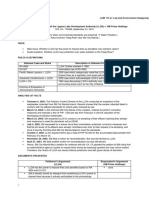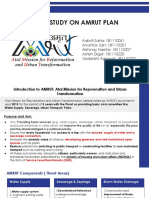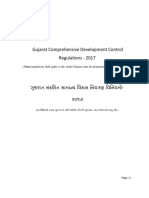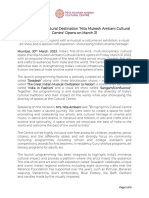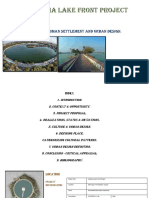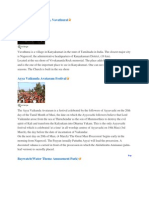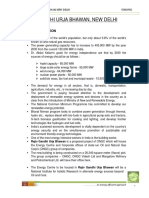0 ratings0% found this document useful (0 votes)
621 viewsSurpur
Surpur
Uploaded by
Nakul ChawdaThe document provides a history of Surpur Samsthana, a principality founded in 1650 AD by the Bedar clan in Gulbarga, Karnataka. It discusses how the Bedars originated from Sage Valmiki and established their capital at Wagingera fort. Over time, they extended their influence over the surrounding areas. Raja Pid Nayaka I defeated a challenge from the Sultan of Bijapur and used the reward to establish the kingdom of Surpur Samsthana. The royal Venugopalaswamy Temple located near the palace is an important architectural and religious site for the region.
Copyright:
Attribution Non-Commercial (BY-NC)
Available Formats
Download as DOCX, PDF, TXT or read online from Scribd
Surpur
Surpur
Uploaded by
Nakul Chawda0 ratings0% found this document useful (0 votes)
621 views12 pagesThe document provides a history of Surpur Samsthana, a principality founded in 1650 AD by the Bedar clan in Gulbarga, Karnataka. It discusses how the Bedars originated from Sage Valmiki and established their capital at Wagingera fort. Over time, they extended their influence over the surrounding areas. Raja Pid Nayaka I defeated a challenge from the Sultan of Bijapur and used the reward to establish the kingdom of Surpur Samsthana. The royal Venugopalaswamy Temple located near the palace is an important architectural and religious site for the region.
Original Title
surpur
Copyright
© Attribution Non-Commercial (BY-NC)
Available Formats
DOCX, PDF, TXT or read online from Scribd
Share this document
Did you find this document useful?
Is this content inappropriate?
The document provides a history of Surpur Samsthana, a principality founded in 1650 AD by the Bedar clan in Gulbarga, Karnataka. It discusses how the Bedars originated from Sage Valmiki and established their capital at Wagingera fort. Over time, they extended their influence over the surrounding areas. Raja Pid Nayaka I defeated a challenge from the Sultan of Bijapur and used the reward to establish the kingdom of Surpur Samsthana. The royal Venugopalaswamy Temple located near the palace is an important architectural and religious site for the region.
Copyright:
Attribution Non-Commercial (BY-NC)
Available Formats
Download as DOCX, PDF, TXT or read online from Scribd
Download as docx, pdf, or txt
0 ratings0% found this document useful (0 votes)
621 views12 pagesSurpur
Surpur
Uploaded by
Nakul ChawdaThe document provides a history of Surpur Samsthana, a principality founded in 1650 AD by the Bedar clan in Gulbarga, Karnataka. It discusses how the Bedars originated from Sage Valmiki and established their capital at Wagingera fort. Over time, they extended their influence over the surrounding areas. Raja Pid Nayaka I defeated a challenge from the Sultan of Bijapur and used the reward to establish the kingdom of Surpur Samsthana. The royal Venugopalaswamy Temple located near the palace is an important architectural and religious site for the region.
Copyright:
Attribution Non-Commercial (BY-NC)
Available Formats
Download as DOCX, PDF, TXT or read online from Scribd
Download as docx, pdf, or txt
You are on page 1of 12
SURPUR
History of Surpur Samsthana
This is the Story oI Surpur Samsthana. A beautiIul place in Gulbarga, hidden in a
remote corner oI Karnataka. Surpur a Place oI mystery, a place oI Iorgotten glory oI lost
legends.
Home to the Beda Nayakas the hunter kings, descendents oI Valmiki. AIter the downIall oI
Vijayanagara Empire many small splinter states emerged in south India and Deccan like
Gudagunti, Ratnagiri, Gadhwal and many more. Surpur Samsthana is one oI the
principalities which came to the main stream oI the South Indian polity. Surpur Samsthana
was Iounded by the Bedars and they ruled during the period 1650-1858 A.D. with their
capital at Wakinkera or Wagingera. The Iort at Wagingera has witnessed great battles
between the rulers oI Surpur and the Mughal emperors. It is worth mentioning here that
emperor Aurangzeb put a seize on the Iort oI Wagingera with the ambition oI capturing the
King oI Surpur Raja Pid Nayaka I in Sagara-nadu or Surpur doab in Gulbarga district.
The Bedar clan is known to be a very Iamous martial tribe known Ior its valor,
bravery and guerilla warIare tactics. Almost all the Iamous emperors including the Mughal
army used to have cavalry oI Bedars which goes to show the importance oI Bedar warriors.
The Bedars trace their origin Irom legendary Iigure Sage Valmiki and Guha.
Col. Meadows Taylor who gives the description oI Bedar soldier warriors saying
that they were good marksmen, sportsmen with a very unique physical built creating a very
dreadIul Iigure.
Origin of Samsthana:
The kaifiyats and the author oI the Bhargava Puranamu give a detailed genealogical
list oI the Samsthana. Guha is the According to these accounts Guha the great devotee oI
Rama was the originator oI the Samsthana Iamily and the rulers oI Samsthana belong to the
4sala lineage. According to the tradition accounts the Gosala lineage was originally the
Protector oI cows and possessors oI cattle wealth.
Meadows Taylor mentioned in his book 'The story oI my liIe mentioned that the ancestors
came Irom Ratnagiri, Anantpur district oI Andhra Pradesh who were small Bedara chieIs
and they migrated to the Raichur doab during the Vijayanagara period. AIter the Talikot
battle in 1565 A.D., the Bedar chieI shiIted their loyalty to the Sultans oI the Adil Shahi
dynasty and they rendered military service to the Sultans.
At Mudgal, the Bedar chieI Kallapa Nayaka made acquaintance with MustaIa Khan,
a Kotwal oI the Mudgal Iort who rendered military service to the Adil Shahis. Later the
successors oI Kallapa Nayaka, Havi Nayaka, his son Peddasoma Nayaka and the latter`s
son Balisoma Nayaka extended their inIluence all over the Raichur doab and occupied the
islands oI the river Krishna, namely, Nilakantarayana Gaddi, Devara Gaddi, Niradevara
Gaddi, Jangina Gaddi, Melina Gaddi, Benachina Gaddi and also the Iamous Jaldurg Iort.
According to the kaifiyats, Pedda Pama Nayaka managed to get the rights oI
collecting taxes in Baichbal samat oI the Shorapur doab (Surpur doab) Irom the Adil
Shahis oI Bijapur. Thus the ancestors oI the Surpur Samsthana made Iooting in Shorapur
doab as IieIs. His son Jakappa Desai (Nayaka) succeeded his Iather`s oIIice and received
the village oI Kakkeri a reward Irom the Adil Shahis. Jakappa Nayaka had two sons, viz.,
Raja Pid Nayaka and Soma Nayaka who were associated with Iather`s oIIice. Taking
advantage oI the weakness oI the Adil Shahis, these two brothers gathered Bedar warriors
and occupied the granitic terrain oI the Krishna River.
Ibrahim Adil Shah the sultan oI Bijapur perceived a threat to his supremacy Irom
ambitious chieItain Irom Kakkeri, Raja Pid Nayaka I also known as Gaddi Pid Nayaka. To
get rid oI the threat Sultan devised a scheme and threw a challenge. Sultan challenged him
to Iace a wild elephant without any weapon. Raja Pid Nayaka I deIeated the elephant in a
public arena and walked away with the reward oI nine lakh rupee which was enough money
to establish a small kingdom. Thus, Raja Pid Nayaka I became the Iounder oI the Surpur
Samsthana.
%%R%ONS OF SURPUR
ROY %P
SR VNUGOPSWY %P
To the west oI the palace on a small hillock a grand temple locally called
Venugopalaswamy temple is royal temple oI the Surpur Samsthana. This is aligned with
Royal Palace (Naya Darbar). The temple Iaces east and is dedicated to Venugopalaswamy,
a Iorm oI Lord Vishnu.
%he yth:
AIter the death oI Aurangzeb in 1708 A.D. Raja Pid Nayak regained Wagingera Iort
and the administration was stabilized, but the king was anguished with his liIe. One day he
was praying to Lord Venugopalaswamy and was telling about his sorrows, as the king was
great devotee oI Lord Venugopalaswamy; God appeared in Iront oI the king and asked him
to walk with him. Walking Ior a long distance they stopped at a hillock and God was
mesmerized with the surroundings, God asked the king to construct a temple on that hillock
(which is now known as aligundu, Surpur town the stone oI maligundu comprising big
monolithic granite rocks is still existing beside the Methodist church in upper m4halla oI
Surpur) and he Iounded a new capital in the middle oI that granitic terrain and named it as
Surpura City oI Gods.
nnual Fair (1atra) and Festivals
Krishna 1anamasthami (Birth of ord Krishna)-
As the Royal Iamily oI Surpur Samsthana worship Lord Venugopalaswamy avatar
oI Lord Krishna, this Iestival has got great importance and is celebrated by all the people
and communities oI Surpur. This Iestival is celebrated according to Hindu Almanac called
'!anchangam. The Janamasthami is celebrated during the month oI Sharavana when the
Sun enters the constellation oI 'Simha (Leo) and moves in the star oI 'Rohini.
On that auspicious day aIter perIorming regular pujas, special pujas are perIormed.
All the Pundits, Acharyas and other arbaris according to the tradition and custom oI
Surpur Samsthana, will gather on that day to perIorm the puja. Everyone keeps Iast on this
day.
On the second day Iasting will be broken by providing Iood/Prasad to Hari Dasas (A
special community which carries the tradition oI singing Hymns in praise oI Lord Krishna
by playing Ektari or small Tamburi). AIter Hari Dasas, all the members oI royal Iamily and
pundits will have the Prasad.
The Jatra is popularly known as Haal4 Kuli meaning spraying oI milk on each
other. This Iestival is to commemorate the child hood leelas oI Lord Krishna who used to
reach the pot oI milk/curd hanging Irom the rooI oI his house by climbing on the back oI
his Iriends. Since Bedars come Irom the Martial clan they are known Ior their valor and
bravery. The ritual oI Stambarohana will give a great encouragement and recognition to the
youth to take up adventure and inIuse the ambition to climb the top.
Royal %emple Features -
The temple oI Lord Venugopalaswamy is located on an elevated place on the Ioot oI
the hillock oI Surpur. The temple is an architectural Ieat and stands Ior the traditional
'astu art oI Surpur artisans. The main temple is built by using beautiIully carved granite
stone available locally. The pillars in the Iront oI the temple are beautiIully erected on the
shoulders oI elephants carved out oI monolithic granites. In precincts oI the temple also
every pillar has a unique carving which reminds us oI architectural acumen oI Vijayanagara
carvings.
Since it is the main temple oI the Samsthana, it has an elaborate plan which consists
oI all components oI the temple such as arbagriha (Sanctum-Sanctorum), Antarala,
Ardhamandapa, Sabhamandapa, pillared mukhamandapa, rectangular pillared veranda, a
vahanamandapa and dvafastamba. The temple is enclosed by prakara walls. A broad Ilight
oI steps on the east leads to the temple. The Adhistana oI the temple consists oI Upana,
Jagati, Tripatta, Kumuda moldings. The tripatta moldings oI the garbagriha antarala and
sabhamandapa are plain, while those oI mukhamandapa contain series oI sculptural panels.
These sculptures include processions, stories oI Krishna, horses, birds, erotic scenes etc.
The exterior walls oI the sabhamandapa and mukhamandapa have sculptures oI snakes,
monkeys, elephants and square medallions with lotus Iigure. The dvarpalas are in tribhanga
posture bearing Vaishnava attributes such as Sanka, Chakra, ada and Abhymudra.
The Sabhamandapa is square on plan and it has Iour main pillars in the center and
has three doorways on the east, south and north. The northern and southern doorways are
simple and contain a lotus Iigure on the lintel. The eastern doorway which leads to the
mukhamandapa is more elaborately decorated. It has Iive sakas which are decorated with
petals, scrolls, diamonds and the IiIth has horizontal bands. The lintel is a rectangular
block which has Vaishnava symbols such as chakra, sanka and ' shaped Vaishnava
mark.
The mukhamandapa is rectangular on plan and consists oI a total oI 38 pillars,
raised kaksasana, and three entrance passages. The tripatta bands oI the pillars a series oI
sculptural panels depicting the scenes oI processions, log snakes, elephants, Hanuman,
Iloral, geometric motiIs, etc.
In the Iront oI the temple is a large stepped well (!ushkarni). It measures 50meters
on each side. It has a large Ilight oI steps on Iour sides. There are rectangular arched
corridors on the northern and eastern sides oI the tank. The arched corridors are plastered
and have the circular medallions and a pair oI Iish Iacing each other.
%YOR NZ
During the Administrative term Col. Meadows Taylor built a house and an oIIice,
popularly called 'Taylor Manzil. This is located on the eastern edge oI the Kudari-gudda
hills and lies to the northwest oI the town, Taylor lived here Ior ten years. The plan and
design oI the complex was prepared by Col. Taylor himselI and it was completed in 1844.
eadows %aylor and Samsthana:
Taylor was born on 25
th
September 1808 at Liverpool in England, in a Merchant
Iamily. He was well versed in Latin, French and English. 00---He came to Bombay in 1824
at the age oI 16 years in search oI job. He worked Ior a short time in Baxter Company at
Bombay and later he Iound a place to serve in Hyderabad state. Slowly he was promoted to
the higher post oI an assistant superintendent oI police. Soon aIter Gresly`s resignation
Taylor was appointed to settle the dispute between the Surpur Samsthana and the Nizam
and established law and order. He arrived at Surpur in 1824 with a letter Irom the Resident.
His Iirst task was to suppress Rani Isvaramma`s growing inIluence and install Pid Nayaka
as care taker` (Diwan) to King. He succeeded in installing Pid Nayaka as the Diwan and
achieved peace in the Capital.
AIter long eIIorts oI Taylor and his request to Governor General, the British Government
agreed to transIer the Iull powers oI Surpur Samsthana to the young Raja Venkatappa
Nayak. AIter a brieI coronation ceremony on 30
th
June, 1853 Taylor handed over all
powers oI the Surpur Samsthana Administration to the young king. Following this Taylor
leIt Surpur in 1853.
Featured of %aylor anzil:
This complex Iollows the European style in layout and it consists oI a house and a
large rectangular oIIice. Both the house and oIIice Iace east. The house has a rectangular
drawing Ilanked by large bedrooms and a dining hall. Two porches are on the eastern and
western ends; these have circular columns in the Iaade. The house consists oI seven doors
and the important Ieature oI these doors was that all the doors used to be opened
simultaneously once the main door was opened. But due to lack oI maintenance only the
center door opens with the main door and other doors shake. The oIIice is to the south oI
the house and it is rectangular on plan. It has an entrance on the east. The oIIice contains a
large nave and two aisles. The walls have number oI windows. Recently, both the residence
and the oIIice have been considerably modiIied and have been made into a guest house. To
the east oI the residence is an isolated boulder which seating arrangements. It is popularly
called Taylor seat. From here one can have a good view oI whole town oI Surpur.
BON BRD SN%URY
The Bonal reservoir is the second largest bird sanctuary in Karnataka aIter
Rangantittu bird sanctuary near Mysore. The reservoir is situated about 110kms south oI
Gulbarga and covers an area oI 40.96 Sq. miles. The reservoir was built in 17
th
century by
Shorapur King Raja Pam Naik, and later Captain Meadows Taylor a Captain in British rule
increased the capacity oI tank Irom 4It to 12It depth.
The name Bonal reservoir is established primarily on Bonal Village. The reservoir
was under the control oI irrigation department, Government oI Karnataka, Gulbarga
Division till 1998. It is an ornithologist`s paradise. The Bonal reservoir is one oI the most
Iavorite hubs oI rare and endangered Aquatic Migratory Birds. Some oI the birds Ilock here
Irom Himalayas and even some birds come Irom snow-kissed hills oI Siberia. October to
January is time Ior travelling birds such as !ainted St4rke, Brahminy duck, Flaming4 etc.
early morning and mid-evening are best viewing time. The best option to reach the
reservoir is by Ioot, a one and halI km walks because most oI the species oI birds are
spotted on the track.
The Bonal reservoir attracts 22 residents, 8 non residents and 8 migratory birds
because oI its perennial nature and availability oI Iood throughout the year. It is a Iavorite
nesting place Ior these birds because oI its Iull vegetation, there is an increased protection
oI Iish population and attraction oI various birds Irom around the world. The most notable
and migratory birds` species in the sanctuary include C4tt4n Teal, Twin tail uck, Bar
Headed 44se, White Necked St4rke, Black Necked St4rke, !ainted St4rke, Flaming4 and
ittle rebe. Apart Irom these migratory birds the local migratory birds which are Iound
here are Large Egret, Brahminy Duck, Common Teal, Common Pochard, Little Ringed
Plover, and Lesser Whistling Teal. Including migratory and local migratory birds one can
also Iind resident birds in the Bonal reservoir which occupy about 33 oI bird population.
Commonly you can Iind Her4ns, 44rhen, C44t, Kingfishers, and Sp4t Bill uck etc.
Fish Iauna is one oI the major components oI the Wetland eco-system oI Bonal reservoir.
Millions oI Iry enter the Bonal reservoir along with the water every year. And as the Iry
reach the reservoir the Iish-eating birds began to congregate in large numbers and breed.
The Iish Iauna oI Bonal reservoir consists oI 24 species belonging to 10 diIIerent Iamilies.
The major types oI Iish Iound in reservoir are ibe li4n catla, R4hu (abe4 r4hita),
Cirrhina mrigala and these Iishes are used Ior Iood by local Iishermen.
The great variety oI colorIul and exciting bird species in the Bonal reservoir attracts
several bird lovers Irom all over the country. The bird watchers always love to visit the
place Ior experiencing the wonderIul daily liIe oI the bird. The best time to visit the
sanctuary is between the months oI October to the end oI January. The visitors are Ierried
in small boats through the Bonal tank and experience a sunrise or a sunset while gliding
gently through the silent waters. There are 6 watchtowers to have a good look at the birds`
behavior Irom diIIerent areas.
To reach Bonal reservoir the nearest railway station is Yadgir which is well
connected with major cities. From Yadgir you can reach Shorapur town (40kms Irom
Yadgir) by NEKSRTC bus, local buses and taxies. You can accommodate at Shorapur
where normal comIort lodges are available near to the bus stand. From Shorapur town you
can reach Bonal reservoir which is about 12kms away by hiring a local three wheeler or by
bus operating between Shorapur and Ammapur.
The Water Bird Sanctuary is actually like a Iairy land Ior birds and looks
picturesque during the evening. Bird watching in this sanctuary can be one oI the greatest
moments oI one`s liIe!
WGNGR FOR%
Wagingera lies 7km to the west oI the Surpur town on the western Ioot oI Surpur
hills. According to the KaiIiyats, the Bedar chieI, Raja Pid Nayaka received Kodekal and
Baichal paraganas Irom Ali Adil Shah oI Bijapur, made his seat at Karshihalli which was
renamed as Wagingera` mountain oI Lord Brahma. AIter deIeating the Bedar army
Aurangzeb renamed it as Rahaman Baksh- Kheda` and rebuilt the Iort and it was under
Mughal occupation till A.D. 1710. During the Mughal occupation a mosque was built
inside the Iort. Soon aIter the death oI Aurangzeb, Raja Pid Nayaka II and recaptured
Wagingera. Subsequently he shiIted his political seat to the newly Iounded stronghold at
Surpur in A.D. 1710 and Wagingera became military station. Later, Raja Venkatappa
Nayaka I added another Iort which lies east oI the Mughals Iort and it is known as
Hosakilla in A.D. 1808, under the supervision oI Diwan Nishti Veerappa.
AIter the death oI Aurangzeb in 1708 A.D. Raja Pid Nayak regained Wagingera Iort
and the administration was stabilized, but the king was anguished with his liIe. One day he
was praying to Lord Venugopalaswamy and was telling about his sorrows, as the king was
great devotee oI Lord Venugopalaswamy; God appeared in Iront oI the king and asked him
to walk with him. Walking Ior a long distance they stopped at a hillock and God was
mesmerized with the surroundings, God asked the king to construct a temple on that hillock
(which is now known as aligundu, Surpur town the stone oI maligundu comprising big
monolithic granite rocks is still existing beside the Methodist church in upper m4halla oI
Surpur) and he Iounded a new capital in the middle oI that granitic terrain and named it as
Surpura City oI Gods.
Fortification
Wagingera Iort occupies the southwestern slope oI Surpur hills which provide
natural deIense to village on the eastern and northern sides. The southern and western sides
are protected by a high deIence wall and broad moat. The Iort known as Padukote` is to
the west oI the village and the Iort known as Hosakilla is to the east. Between these two
Iorts and to the north oI the village is a large reservoir known as Anesondikeri which
serves as a moat to the Iort and the village.
Padukote
It is built on the elevated hillocks which rise nearly 80m above the ground level.
The Iort is rectangular on plan and measures 350 m by 240 m. the Iort wall is built with
dressed granite blocks and is plastered on both sides. The wall measures 4m to 5m in
height and 1.5m in thickness. The Iort wall is broken down by a total oI 9 bastions and two
gates. The walls are built with blocks having Iloral and geometric decorations and also
have Iragments oI pillars, capital blocks etc. oI Hindu temples. The eastern gateway known
as 'RamDarwaza` leads to the citadel complex.
ttractions in Padukote:
Padukote has a mosque, a stepped well, a ruined temple, a large number oI ruined
structures in the centre and a small water reservoir on the western end.
Mosque:
It is located to the west oI the Ram-Darwaza. It is rectangular on plan and measures
24m by 13m. It has a prayer hall and an open court. It has entrances on the eastern and
southern sides. Two graves are Iound inside the open court. The rooI and Iaade oI the
prayer hall have collapsed. It appears that the Iaade had an arched opening as vaults and
angles oI the arches intact.
Venugopalaswamy %emple:
It is locally believed that this structure served as the temple oI Venugopala and was
destroyed during the Mughal occupation when they reconstructed the Iort the Mughals used
the eastern and southern walls oI the temple as a part oI the wall. The plan oI the structure
is not clear, since it has been destroyed. The plinth has horizontal bands such as upana,
fagati, tripatta and kap4ta. Well-Iinished temple pillars, pilasters, beams, lintel beams,
ceiling blocks and doorIrame blocks are lying immediately to the north oI this ruined
structure. Interestingly these are kept in sequence. A small shrine oI lord Venugopala
against a huge boulder to the northwest oI this structure is being worshipped by the royal
descendants as well as the village Iolk.
Brahmadeva Gudi (%emple Of Brahma):
This is located outside the city walls, 1km to the southeast oI the village. The square
structure occupies the centre oI a large square platIorm. It Iaces the east and wall is carved
with Iloral and geometric design. The doorway has Iive sakas carved with horizontal Iloral
motiIs. Above the lintel is a row oI hanging leaves and Iloral carvings. Behind the structure
is a stepped well.
SURPUR P
The citadel complex consists oI two large palaces; the one on the north is known as
Hale Darbar (Old Palace) and other on the south is known as Naya Darbar (New Palace).
According to KaiIiyats the old palace was built during the period oI Raja Venkatappa
Nayaka I. It occupies a large area oI the complex. The palace consists oI a tower like Iour
storey structure at southwestern corner, two vaulted rectangular halls, a rectangular hall
with Iive arched openings and several large rectangular courtyards. The palace is being
used by Government schools.
Naya Darbar:
The southern part oI the citadel complex is occupied by the Naya Darbar or New
palace. This palace was built during the Iourth decade oI 19
th
century under the
supervisions oI Col. Meadows Taylor. In his autobiography he gives day to day account oI
the progress oI construction.
This beautiIul palace is also known as wooden carvings. The ceilings and the pillars
are beautiIully carved in wood. The palace has three storeys residential. This three storey
structure Iaces east and is square on plan. A small door leads to a passage. The ground
Iloor consists oI a large open court to the south oI the open court is a Iront hall. The
important rooms in this palace are a kitchen, padasale (Iront hall), wooden pillared halls,
Puja room etc. which are beautiIully decorated with wooden ceilings. The palace also
consists oI a well and a small garden. We can also Iind the house oI noble men. These were
named aIter the titles oI various oIIicials such as Diwan mane, Gurikar mane (mane
means house in Kannada). It consists oI the same room as in the palace.
You might also like
- LLDA v. SM Prime Holdings Digest (Villarey)Document2 pagesLLDA v. SM Prime Holdings Digest (Villarey)Third VillareyNo ratings yet
- Case Study On Amrut PlanDocument69 pagesCase Study On Amrut PlanRahul Mass100% (1)
- Rajasthan PresentationDocument14 pagesRajasthan Presentationnavink162No ratings yet
- Construction of of Hockey StadiumDocument2 pagesConstruction of of Hockey StadiumShoaib AkramNo ratings yet
- Summary IMSWM Narela-BawanaDocument43 pagesSummary IMSWM Narela-Bawanavj4249No ratings yet
- Electronic Payment SystemDocument46 pagesElectronic Payment SystemNakul Chawda100% (2)
- The Group AssessmentDocument2 pagesThe Group AssessmentFaqihah HaslubisNo ratings yet
- Ancient Egyptian Sexual AnkhingDocument4 pagesAncient Egyptian Sexual AnkhingTalon Bloodrayn100% (6)
- Indian Solar Radiation Data AnalysisDocument19 pagesIndian Solar Radiation Data AnalysisabhywaNo ratings yet
- FINAL Comprehencive GDCR PDFDocument339 pagesFINAL Comprehencive GDCR PDFuashindeNo ratings yet
- Sushil Hari International SchoolDocument17 pagesSushil Hari International SchoolsvprskNo ratings yet
- India - Surat - City Presentation - Cities and Resilience DialogDocument25 pagesIndia - Surat - City Presentation - Cities and Resilience DialogheavensangelsNo ratings yet
- Gulbarga FinalDocument29 pagesGulbarga FinalDeepak PatelNo ratings yet
- RajasthanDocument13 pagesRajasthanbharatkumawatNo ratings yet
- NMACC Launch 31mar2023Document3 pagesNMACC Launch 31mar2023G SaxenaNo ratings yet
- Report On Mandi VisitDocument2 pagesReport On Mandi VisitPrathap G MNo ratings yet
- Project Report 101Document5 pagesProject Report 101Noor SabaNo ratings yet
- Importance of ByelawsDocument10 pagesImportance of ByelawsPALKI GHAINo ratings yet
- Phsud Kankari Lake Urban DesignDocument26 pagesPhsud Kankari Lake Urban Designravi ram100% (2)
- Delhi Master Plan 2021Document30 pagesDelhi Master Plan 2021sameerwarsiNo ratings yet
- INTACH. PPT Student Group WorkDocument10 pagesINTACH. PPT Student Group Work10Radha GaikwadNo ratings yet
- Kanyakumari TourDocument25 pagesKanyakumari TourAmol PethkarNo ratings yet
- Re-Establishing Link Between Water Bodies and Human Life-An Attempt For Rejuvenation of Water BodiesDocument10 pagesRe-Establishing Link Between Water Bodies and Human Life-An Attempt For Rejuvenation of Water BodiesInternational Journal of Innovative Science and Research TechnologyNo ratings yet
- Kalyan Dombivli Solar City Master PlanDocument137 pagesKalyan Dombivli Solar City Master PlanPradeep S Methakar100% (1)
- Architectural Design: Pimpri - Chinchwad MSRTC Bus StandDocument10 pagesArchitectural Design: Pimpri - Chinchwad MSRTC Bus StandsagrikakhandkaNo ratings yet
- Design & Implementation of 17.25 KVA Solar Power Plant-IJAERDV04I0237283Document8 pagesDesign & Implementation of 17.25 KVA Solar Power Plant-IJAERDV04I0237283Editor IJAERDNo ratings yet
- Solar Water Heater and Solar Cooker Working Priniciples and Its ApplicationsDocument10 pagesSolar Water Heater and Solar Cooker Working Priniciples and Its ApplicationsSai PranayNo ratings yet
- Tenkasi City PlanDocument191 pagesTenkasi City PlanChenthur GardenNo ratings yet
- Assignment Report: On Food Habits of Lepcha's Community in Sikkim & Business PerspectiveDocument18 pagesAssignment Report: On Food Habits of Lepcha's Community in Sikkim & Business PerspectiveSachin ChauhanNo ratings yet
- ChintadaripettaiDocument18 pagesChintadaripettaiVirajitha ChimalapatiNo ratings yet
- 1 Dissertation Review-1 - Campus LandscapeDocument12 pages1 Dissertation Review-1 - Campus LandscapeAr Deepika RajaNo ratings yet
- Rajasthan Solar Energy Policy 2019Document46 pagesRajasthan Solar Energy Policy 2019V S MITTALNo ratings yet
- CIDCO Plan For Taloja & KhargharDocument14 pagesCIDCO Plan For Taloja & KhargharAnubhav GuptaNo ratings yet
- Indo IslamicDocument24 pagesIndo IslamicAbishekNo ratings yet
- Sopanam School of PanchavadyamDocument9 pagesSopanam School of Panchavadyamsanthosh alamkode limca book of records hollderNo ratings yet
- Site and Services SchemeDocument32 pagesSite and Services SchemePreethi Mariappan33% (3)
- Preview of India Solar PV Advisor PDFDocument28 pagesPreview of India Solar PV Advisor PDFsudhakarcjNo ratings yet
- Synopsis PDFDocument7 pagesSynopsis PDFSharda SharmaNo ratings yet
- Kedarnath DisasterDocument11 pagesKedarnath DisasterShilpi AgarwalNo ratings yet
- Waaree Corporate PPT - V3Document53 pagesWaaree Corporate PPT - V3Bhushan MalsheNo ratings yet
- Landscape Study of Hindu Temples - 1Document12 pagesLandscape Study of Hindu Temples - 1aishwarya ramakrishnanNo ratings yet
- The Making of Successful Public Space: A Case Study of People's Park SquareDocument6 pagesThe Making of Successful Public Space: A Case Study of People's Park SquareamlaNo ratings yet
- Administrative Block For N.I.T. Raipur (New Campus) Towards A Green BuildingDocument28 pagesAdministrative Block For N.I.T. Raipur (New Campus) Towards A Green BuildingPranav Mishra80% (5)
- KedarnathDocument8 pagesKedarnathMukundan PolurNo ratings yet
- Ravan Was A Gond King.Document10 pagesRavan Was A Gond King.Mercy NagNo ratings yet
- Village Development ReportDocument45 pagesVillage Development ReportMukulNo ratings yet
- 5-6 DravidianDocument61 pages5-6 DravidianApoorva JainNo ratings yet
- Final Site AnalysisDocument9 pagesFinal Site AnalysisApurva MahadikNo ratings yet
- Supply and Distribution of Electricity To BuildingsDocument33 pagesSupply and Distribution of Electricity To BuildingsAgneyi BalluNo ratings yet
- Jawahar Kala Kendra by Charles CorreaDocument5 pagesJawahar Kala Kendra by Charles CorreaDeepika Reddy67% (3)
- Shri Kshetra GanagapurDocument28 pagesShri Kshetra GanagapurGurudas PaiNo ratings yet
- Konkan Culture: Palghar, Thane, Mumbai, Raigad, Ratnagiri, SindhudurgDocument4 pagesKonkan Culture: Palghar, Thane, Mumbai, Raigad, Ratnagiri, SindhudurgApurva mahadikNo ratings yet
- SCR MODULE-2 REPORTDocument7 pagesSCR MODULE-2 REPORTGouse Sk Gouse SkNo ratings yet
- Jaipur The Pink CityDocument26 pagesJaipur The Pink Cityगुंजन आशीष श्रीवास्तवNo ratings yet
- Detailed Project Report On Development of Modern Terminal Market For Fruit & Vegetables at NasikDocument418 pagesDetailed Project Report On Development of Modern Terminal Market For Fruit & Vegetables at Nasiksouravroy.sr5989No ratings yet
- Temple ArchitectureDocument6 pagesTemple ArchitectureKiran Kumar KanduriNo ratings yet
- Thesis of Raju BhattaraiDocument92 pagesThesis of Raju BhattaraiFgNo ratings yet
- Traditional Systems of Water Management in India - (Arnav-2013MUD007)Document10 pagesTraditional Systems of Water Management in India - (Arnav-2013MUD007)arnav saikia100% (1)
- Ambuja Mall, Raipur: Submitted To - Ar. Madhura HanjiDocument17 pagesAmbuja Mall, Raipur: Submitted To - Ar. Madhura HanjiParimal ShindeNo ratings yet
- 2b.2 BRT Amritsar LaghuParasharDocument36 pages2b.2 BRT Amritsar LaghuParasharranisushma1986No ratings yet
- Dimensions of UrbanizationDocument5 pagesDimensions of UrbanizationIrraz Bin Idris100% (1)
- Swami Ayyappan The Reality and The Asianet MythDocument7 pagesSwami Ayyappan The Reality and The Asianet MythchamundihariNo ratings yet
- Ancient & Medival HistoryDocument20 pagesAncient & Medival HistorySHUBHAM KAMALNo ratings yet
- Sri Ayyappa Swami: LegendsDocument6 pagesSri Ayyappa Swami: LegendsKarthick VellasamyNo ratings yet
- The Biological Diversity Act 2002 and Rules 2004 Concerns & IssuesDocument6 pagesThe Biological Diversity Act 2002 and Rules 2004 Concerns & IssuesNakul ChawdaNo ratings yet
- AurangDocument1 pageAurangNakul ChawdaNo ratings yet
- Mysore SoftDocument18 pagesMysore SoftNakul ChawdaNo ratings yet
- Pre Assessment Answers Mod6Document3 pagesPre Assessment Answers Mod6Syafiq HakimNo ratings yet
- Fundamental Counting PrincipleDocument14 pagesFundamental Counting PrincipleKing Joshua AdrianoNo ratings yet
- Cyber-Security and Private Actors in AnDocument11 pagesCyber-Security and Private Actors in AnOgunjimi Taofiki AdebisiNo ratings yet
- Ep7 Investigative Judgment Vs Gospel PDFDocument8 pagesEp7 Investigative Judgment Vs Gospel PDFArnold Abacan100% (1)
- 111 AffirmationsDocument15 pages111 Affirmationsanand kumarNo ratings yet
- Chromosomal Abnormalities PP TDocument21 pagesChromosomal Abnormalities PP TWency BondocNo ratings yet
- ASI (Archaeological Survey of India) : Submitted To: Ar. Sachin Goyal Submitted By: Renu Gill Seekha Tanwar Sachin VermaDocument20 pagesASI (Archaeological Survey of India) : Submitted To: Ar. Sachin Goyal Submitted By: Renu Gill Seekha Tanwar Sachin VermaNishima GoyalNo ratings yet
- Final Pit 2020 IsbnDocument20 pagesFinal Pit 2020 IsbnYohanes FirmansyahNo ratings yet
- Classification and Psychopathology ResearchDocument8 pagesClassification and Psychopathology ResearchAmy Fisher SmithNo ratings yet
- Vda. de Ramos vs. Court of AppealsDocument17 pagesVda. de Ramos vs. Court of AppealsDianne May CruzNo ratings yet
- NIMH4 S-DBT Diary Card InstructionsDocument2 pagesNIMH4 S-DBT Diary Card InstructionsTrevaNo ratings yet
- Writing-Grammar (PDFDrive)Document63 pagesWriting-Grammar (PDFDrive)bushra shaif50% (2)
- Smith V Tamworth City CouncilDocument3 pagesSmith V Tamworth City Councilshivam kNo ratings yet
- Sermons Topics Books Podcasts: ArticlesDocument11 pagesSermons Topics Books Podcasts: ArticlesMarnie GodienesNo ratings yet
- Mark's Grade 7 sp1 Holiday Assignment Term 1 - 2020 PDFDocument4 pagesMark's Grade 7 sp1 Holiday Assignment Term 1 - 2020 PDF360MaRko oo.No ratings yet
- The Eratosthenes Experiment in Our SchoolDocument19 pagesThe Eratosthenes Experiment in Our SchoolKrsto MaslesaNo ratings yet
- IPRU InsightsDocument13 pagesIPRU InsightssandeepNo ratings yet
- Barletta Et Al 2023 A Systematic Approach To Understanding AcidDocument11 pagesBarletta Et Al 2023 A Systematic Approach To Understanding AcidVeronica Romero MouthonNo ratings yet
- 2813 01jan08t41131Document12 pages2813 01jan08t41131Philip_830No ratings yet
- Set 6Document24 pagesSet 6Soumava BasuNo ratings yet
- Starkville Dispatch Eedition 9-25-19Document16 pagesStarkville Dispatch Eedition 9-25-19The DispatchNo ratings yet
- Constantino Vs MendezDocument1 pageConstantino Vs MendezJo JosonNo ratings yet
- Boucherit Oussama F1Document55 pagesBoucherit Oussama F1Najoua NajouaNo ratings yet
- The Scope and Method of EconomicsDocument14 pagesThe Scope and Method of EconomicsAman PratikNo ratings yet
- Copia de 2006 - Help For Worried Kids How Your Child Can Conquer Anxiety and Fear - C.lastDocument288 pagesCopia de 2006 - Help For Worried Kids How Your Child Can Conquer Anxiety and Fear - C.lastLucina Pérez GarateNo ratings yet
- Library of Broken Worlds ExcerptDocument27 pagesLibrary of Broken Worlds ExcerptI Read YANo ratings yet
- Rephrasing 3 RespuestasDocument2 pagesRephrasing 3 RespuestasEsteban Felipe Cano GarcíaNo ratings yet
